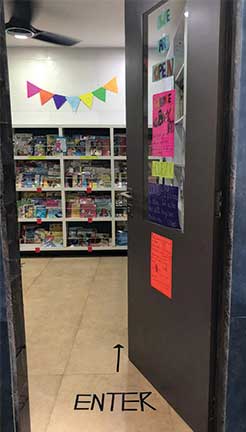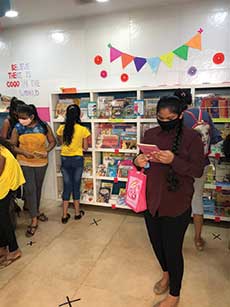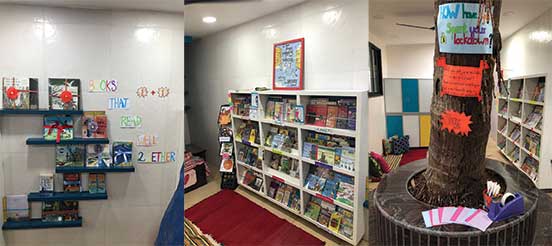Judith Thomas
The unprecedented events of 2020 forced all schools to shut down, compelling them to move completely online. Our school, which adheres to the state board curriculum and follows a strict pen and paper approach to learning, was rudely awakened to the reality of the new circumstances. What followed over the next few months was intensive teacher training to update our teachers’ skills so as to move schooling online.

If there was one space that was largely neglected during the initial days of the lockdown, it was the library. After all, how could we transfer an entire space dedicated to books, browsing and reading completely online? Even if we succeeded, what about the sense of community that a library must harbour? With the pandemic, children found themselves locked in their homes, isolated, alone and often lost in their own feelings and emotions. We felt that with the re-opening of the school library we could give children an opportunity to move out of their homes, meet their peers, make small but important choices for themselves – giving them a sense of autonomy and freedom. These were some of the reasons that led us to open the library physically to our students in late 2020. Through the library space we hoped to reconnect with our students, building a bridge between school and the online learning space.
Bridges need strong foundations. The foundation for our library is our newly formed vision. Our school library is still young. It was nurtured back to life from disuse during 2018-19. We were in the process of reviewing our collection, reimagining our vision and creating a reading community when the pandemic hit.
In a state board curriculum school, where all focus lies on academics, the library is looked at only from the point of view of something extra-curricular. Reading is limited to textbooks and textbooks do not lend themselves to immersive reading. This in turn hinders students from developing the skill for leisurely reading. By this I mean self- selected, independent reading for fun, pleasure or for personal reasons. This is not encouraged by parents for they see little to no value in it. Parents and children often limit their understanding of reading as identifying and deciphering the written word. So a fluent reader would then be someone who can do this quickly and easily. However, in reality, deep reading takes place when the reader can make a connection between text and context. This is possible only when a child associates reading their world with reading the word. Mainstream education in India does not lend itself to this. This is mainly because reading is reduced to a monotonous, mechanical drill of spelling out or memorizing without truly understanding the essence of it. Therefore, reading outside the curriculum is not considered to be important.
Hence, a crucial step for us was to create curiosity and interest around books,stories and the library in general. We wanted students to move away from the tedium they usually associate with the act of reading. Leave no reader behind! We wished to create an open, accessible space where free choice is encouraged and appreciated. A space where open dialogue can take place, a space wherein a reader can grow individually and as part of a group.

A first step was to change the layout of the library. We removed the tall cupboards with shut doors and made open shelves that are accessible to even our youngest reader. We organized the books in ways that were easy for children to search for books they desire. We encouraged free choice by not creating any restrictions over book selection, every reader was free to follow his/her heart. Library classes were scheduled into the timetable, where stories were read together, discussed and activities were conducted in groups and independently. We also revisited our collection and began building a collection of diverse books that helped every child connect to the larger world around them.
After being a part of the Library Educators Course in 2019, I took on the idea that a library should be conducive to discovery and exploration. I learnt that books can and should be windows and mirrors to the world and self. Through the course, I learnt not to impose my own judgment or ‘likes’ on a reader. I realized the importance of self-discovery and trust. A love for reading cannot be forced but must be nurtured. It is also through this course that I found a set of like-minded people who formed a community of trust and support, who shared their journeys and discoveries as they grew in their practice.
Silver lining
As a library educator during the pandemic, I noticed a few significant changes happening among the regular visitors. Students took their time to browse a collection. There was also no sense of urgency in choosing a book like in regular school hours, wherein the entire class of 60 students got about 35 minutes to browse, choose and issue a book. I also got one-on-one time with my primary school students, who sometimes feel so overwhelmed by the idea of free choice. Giving them simple tools like the 5 finger rule, helped build their confidence in choosing a book. Talking to them, reminding them to put thought into choosing a book did change their browsing and borrowing patterns. They began to ask me for books they were looking for, they took their time to explore and choose.
I could also ask children why they chose a particular book or what attracted them to it? I would check with them if they had read the blurb or at least flipped through the pages to better understand what the book has to offer. I could ask them for their preferences and recommend books I felt they may like. On returning the books, we had conversations over the plot, characters, genre. This helped me gauge the reading levels of my students, while at the same time nudging them towards different authors and styles of writing. Abbas, who is in standard 7 now was an ardent fan of Geronimo Stilton. On enquiring about his fondness for these books, I discovered his penchant for detective novels. He enjoyed the thrill of following the clues to discover the culprit. I recommended a few books that fell under the whodunit genre. Abbas chose to pick up a Satyajit Ray novella: The Emperor’s Ring. He went on to read all available Satyajit Ray books from the library. He is now currently reading Lock 14 by George Simenon.
During this period we noticed that some books were not being borrowed. We decided to re-shelve books to encourage mindful browsing. I noticed that older students would make a beeline to the shelves that they knew catered to their choices. This led to some shelves being completely ignored, like that of short stories and autobiographies. We hoped students would gradually change their patterns and explore the library with more intent. Not only did we re-shelve books belonging to certain genres, we also introduced some new categories like the mystery shelf, early readers and art inspired books. We also added the ‘We Recommend’ shelf to the mix, labelling these books with a gold sticker. My fellow library educators and I personally vetted these books. The books that qualified for this shelf had to provide young readers with diverse perspectives about the world they live in and about themselves. Through this shelf there was more movement of good children’s literature. Children are slowly moving away from Goosebumps and Geronimo Stilton. Michael Morpurgo and Patricia Polacco are now the top books flying off our shelves. This is indicative of the choices and taste changing amongst the small group of regular readers.
I continued to have displays around special days, occasions and even genres in the library in an attempt to spotlight certain books from our collection. While some students did choose to borrow books from displays, they weren’t as conscious of the different elements around these displays. During September to celebrate World Literacy Day and bring more students into the library we introduced a month long offer – borrow two books instead of one. With this offer we had a special display which had curated sets of two books, ready to be borrowed. These books were connected to each other either through theme, plot or genre. [A few examples of the books from the display – ‘Books That Go Well 2gether’ – Kali Wants to Dance + Sadiq Wants to Stitch, Lost and Found: In a Mumbai Koliwada + Bombay Ducks, Bombay Docks]. A short questionnaire was also provided to help students make comparisons, draw on similarities and share their preferences. We did get better traction on this display, some students even returned the questionnaire filled. I have learnt through this experience that displays as an element in the library requires a lot more dialogue. There seems to be hesitancy from children to engage/participate.

While work went on in the physical space of the library, online library classes continued. We made it a point to schedule library periods for every class so that there was at least one weekly session. Reading, discussions, activities continued to take place. But how impactful these sessions were is unclear. In general, students look at the library class as a fun but easily missed class. They aren’t as focused or receptive during these sessions making it difficult for me to sense the pulse of the class. Class-wise online reading bookshelves are organized for the primary section to give students opportunities to keep up with their reading. But the number of students accessing these resources isn’t clear. With no tangible evidence to support the impact of online library classes, it becomes even more crucial to ensure libraries and schools open their doors to students soon!
As rules eased in our city, students complained about not finding time to visit because of their tightly packed schedules. As a library educator I realized I had an important role to play in sustaining and encouraging students to read but I soon became aware that I could not bring about a change all by myself. This change can happen only with the help and cooperation of other teachers. For this, teachers must also become readers. They must visit the library often, browse the collection, read and pass on recommendations to their students and fellow teachers. They too must look at the library as a resource they can use to enrich their lessons.
We hope to encourage teachers to explore the collection, initiate dialogue with each other and break away from preconceived notions around books and the act of reading. For this we conducted a few online as well as offline sessions with teachers. During one such physical session, teachers were asked to do paired reading. Two teachers found themselves reading ‘Guthli has Wings’ by Kanak Shashi, Tulika publishers, 2020. Both teachers were deeply perturbed by this book, they shared with the rest of the group their surprise and perhaps even shock in finding gender identity issues highlighted through a children’s picture book. What ensued were conversations around the book, what genre did it belong to? Is it a suitable book for young readers to read? What is the ideal age to introduce such a book to readers? This got the other teachers curious, they wanted to read the book for themselves before forming an opinion. This is the kind of engagement that we hope to achieve by opening up the library and good literature to our teachers. However, it must be noted that this is still a work in progress that requires commitment, time and dedication from both the teachers and the library educators.
While I am happy to get to know and witness change happening in the small fraction of regular readers and teachers, it raises the question – what about the rest? Will these interventions show results when regular school life resumes? What about the loss of time some children might have suffered due to this isolation and lack of a reading community?
I wait to find out.
The author loves to read and spread the joy of reading. After completing the Library Educator’s Course in 2019, she, along with the help of Sharon English High School’s Management, reinvented the library space to make it more fun, impactful and accessible to all. She can be reached at judith.thomas@sharonschool.in.
